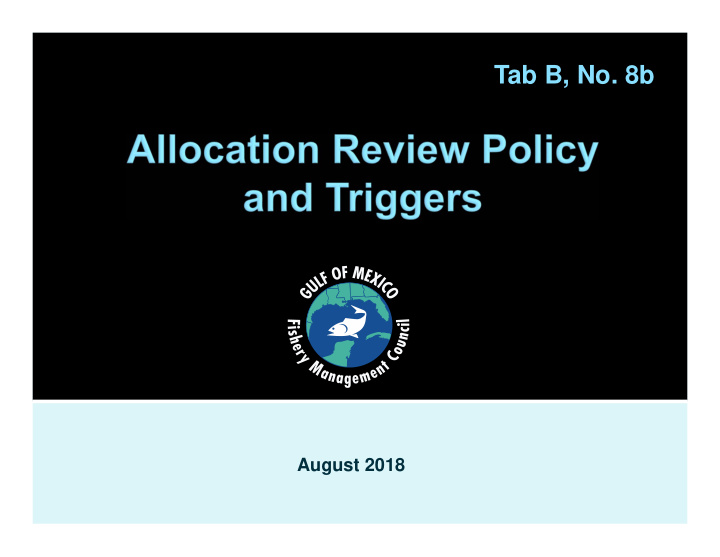



Tab B, No. 8b T August 2018
To assist Councils in reviewing existing fisheries allocations and reallocating resources, NMFS and the Council Coordination Committee developed Fisheries Allocation Review Policy (NMFS Policy Directive 01- 119) Procedural directives addressing criteria for initiating allocation reviews (NMFS Procedural Directive 01-119-01) and Recommended practices and factors to consider when reviewing and making allocation decisions (NMFS Procedural Directive 01- 119-02).
Fisheries Allocation: is defined by NMFS as a “direct and deliberate distribution of the opportunity to participate in a fishery among identifiable, discrete user groups or individuals.” Fisheries Allocation Review: the evaluation that leads to the decision of whether or not the development and evaluation of allocation options is warranted, but is not, in and of itself, an implicit trigger to consider alternative allocations. Evaluation of Fisheries Allocation Options for an FMP Amendment : If the allocation review determines a reallocation is warranted then the full analysis and evaluation of allocation options should be initiated. The goal is an FMP amendment (or framework action) to update the allocation or maintain status quo.
Fisheries Allocation Review Policy recommends the use of adaptive management for allocation reviews. Adaptive management : the on-going process of evaluating if management objectives have been met and adjusting management strategies in response. Process includes periodical re-evaluation and updating of the management goals and objectives to ensure they are relevant to current conditions and needs.
Council is responsible for establishing review triggers (selecting the criteria for initiating fisheries allocations reviews) Triggers suggested include time-based, public interest-based and, indicator-based criteria. For indicator-based criteria, Council must lay out the process to assess whether the trigger is met. Council should identify allocation review triggers by August 2019 or as soon as practicable. Policy recommends a three-step process
Review triggers: criteria for initiating allocation reviews Policy considers 3 types of triggers: public interest-based triggers; time-based triggers; and indicator-based triggers
Council management system is transparent and open to public input throughout the process Public input on fishery allocation review would feed into the process. Guidance on public interest at three different levels within the regional fishery management council process: Ongoing public input on fishery performance Solicitation of public comment regarding allocation review Formal initiatives
Council process is open, transparent, and offers frequent opportunities for public comment and input Feedback loop between the Council and the public for specific issues under the Council’s consideration and indicators of fishery performance. Public interest in allocation review is likely to be expressed at many points within the council process
Deliberate and specifically targets public input on the need for allocation review Council has the ability to dictate the schedule but should be aware of the expectations among stakeholders Council should carefully consider its ability (resources and capacity) and willingness to follow through with an allocation review if warranted before reaching out to the community for focused input.
Stronger public interest review mechanism could be a stakeholder request or petition requesting review, Petition would require the Council to initiate an allocation review within a reasonable period of time It may be appropriate to incorporate indicator-based criteria to establish a minimum threshold for initiating review. Council should establish guidelines for petitions
Periodic allocation review on a set schedule is the most simple and straightforward criterion the approach is less vulnerable to political and Council dynamics. Mandates of a strict schedule render time-based criteria less sensitive to other council priorities Most suitable for those fisheries where the conflict among sectors or stakeholders make the decision to initiate a review so contentious that use of alternative criteria is infeasible
MSA requires that fisheries be managed for Optimum Yield (OY), which is Maximum Sustainable Yield (MSY) as reduced by relevant social, economic and ecological factors Indicator-based criteria to consider as triggers for initiating review of allocations, all stem from the definition of OY: social, economic and ecological. When using indicator-based criteria as a trigger for allocation review, the use of several criteria, singly or in combination, and across multiple categories, may be optimal
Economic Criteria : Multiple tools, e.g., cost-benefit analysis, economic impact analysis, efficiency analysis. Public understanding of the differences between and proper use of these tools is often limited Social Criteria: Studies have been published detailing the development and measurement of social metrics such as community resilience, vulnerability and well-being. Councils may choose to select several indices among the above categories Social and economic impacts are often linked. Ecological Criteria: Changes in fishery status resulting from a stock assessment, increases in discards, and changes in species distribution and food web dynamics are all examples of factors that may influence an allocation review.
The Council has apportioned (or is considering the allocation of) fisheries resources between various groups, including allocations: between the commercial and recreational sectors within the recreational sector, i.e., between the federal for- hire and the private angling components; between the Gulf and South Atlantic; and between the five states in the Gulf of Mexico.
Gulf of Mexico Fisheries Allocations between Sectors Allocation (%) Amendment Stock (year of implementation) Commercial Recreational Red Snapper 51% 49% Reef Fish 1 (1989) Gag 39% 61% Reef Fish 30B (2008) Black grouper 73% 27% Generic ACL/AM (2012) Red grouper 76% 24% Reef Fish 30B (2008) Gray triggerfish 21% 79% Reef Fish 30A (2008) Greater 27% 73% Reef Fish 30A (2008) amberjack King mackerel 32% 68% CMP 2 (1987) Gulf group Spanish mackerel 57% 43% CMP 2 (1987) Gulf group
Allocation within the recreational sector : 42.3% and 57.7% of the recreational red snapper ACL to the federal for-hire and private angling components, respectively Allocation between the Gulf and South Atlantic: 47% of the black grouper ABC to the South Atlantic and 53% to the Gulf of Mexico; 75% of the yellowtail snapper ABC to the South Atlantic and 25% to the Gulf of Mexico; and, 82% of the mutton snapper ABC to the South Atlantic and 18% to the Gulf of Mexico.
Steps to follow to implement the allocation review policy
Thank you
Recommend
More recommend